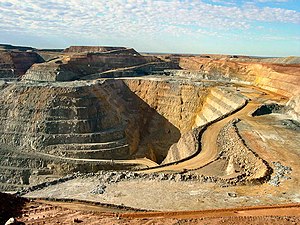Super Pit gold mine

Super Pit gold mine, c. 2005
|
|
| Location | |
|---|---|
| Location | Kalgoorlie |
| State | Western Australia |
| Country | Australia |
| Coordinates | 30°46′29″S 121°30′34″E / 30.77472°S 121.50944°ECoordinates: 30°46′29″S 121°30′34″E / 30.77472°S 121.50944°E |
| Production | |
| Production | 690,000 |
| Financial year | 2009 |
| History | |
| Opened | 1893 |
| Owner | |
| Company | Kalgoorlie Consolidated Gold Mines Pty Ltd |
| Website | superpit |
| Year of acquisition | 1989 |
The Fimiston Open Pit, colloquially known as the Super Pit, was Australia's largest open cut gold mine until 2016 when it was surpassed by the Newmont Boddington gold mine also in Western Australia. The Super Pit is located off the Goldfields Highway on the south-east edge of Kalgoorlie, Western Australia. The pit is oblong in shape and is approximately 3.5 kilometres long, 1.5 kilometres wide and 570 metres deep. At these dimensions, it is large enough to be seen from space.[1]
The Super Pit is owned by Kalgoorlie Consolidated Gold Mines Pty Ltd, a company owned 50/50 by Barrick Gold Corporation and Newmont Mining Corporation. The mine produces 850,000 ounces (28 tonnes) of gold per year, and employs around 550 employees directly on site.
Earlier stages[edit]
Originally consisting of a number of small underground mines, consolidation into a single open pit mine was attempted by Alan Bond, but he was unable to complete the takeover. The Super Pit was eventually created in 1989 by Kalgoorlie Consolidated Gold Mines Pty Ltd.[2]
Barrick Gold acquired its share of the mine in December 2001, when it took over Homestake Mining Company . Newmont became part-owner of the mine three months later, when it acquired Normandy Mining in February 2002.[3]
Geology[edit]
Most of the good gold mined in the Super Pit occurs within ore lodes formed by ancient shears in a rock unit called the Golden Mile Dolerite. The gold mining area of Kalgoorlie-Boulder-Fimiston has long been called the Golden Mile because of the geographical concentration of rich mines in that area, even though the lodes occur in an area over 2 km in width and 1 km in depth. It also mines nickel.
Production[edit]
Mining is via conventional drill and blast mining via face shovels and dump trucks. Around 15 million tonnes of rock is moved in any given year, consisting primarily of waste rock.
Gold within the Golden Mile lode system is unusual in that it is present as telluride minerals within pyrite. In order to recover the gold, the ore must be crushed, passed through a gravity circuit to recover the free gold present in some of the higher-grade lodes, and then subjected to flotation to produce an auriferous pyrite concentrate. This is then roasted at a small smelter outside Kalgoorlie-Boulder to liberate the gold from the tellurides, with doré bars poured.

Figures[edit]
Past production figures were:[4]
| Year | Production | Grade | Cost per ounce |
| 1998-99 [5] | 718,554 ounces | 2.37 g/t | US$236 |
| 2000 | 715,164 ounces | 2.27 g/t | A$325 |
| 2001 | 616,344 ounces | 2.14 g/t | A$397 |
| 2002 | 720,050 ounces | 1.73 g/t | A$222 |
| 2003 | |||
| 2004 | |||
| 2005 | |||
| 2006 | |||
| 2007 | 628,000 ounces | 1.53 g/t | |
| 2008 | 612,000 ounces | 1.56 g/t | |
| 2009 | 690,000 ounces | US$609 | |
| 2010 |
| Wikimedia Commons has media related to Super Pit Gold Mine. |
References[edit]
- ^ Perth Now: "Super Pit 'Scars' Earth"
- ^ Treadgold, Tim. (1995) History of the pit's development from 1989 to 1995 Australia's mining monthly, May 1995, p. 31, 33-36,
- ^ MINEDEX website Golden Mile / KCGM search result, accessed: 26 January 2010
- ^ The Australian Mines Handbook - 2003-04 Edition page: 127
- ^ Normandy Mining Ltd - 1999 Mine-by-Mine Operating Results accessed: 14 February 2010
